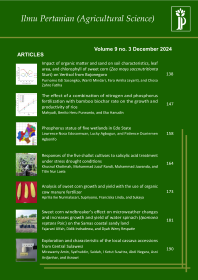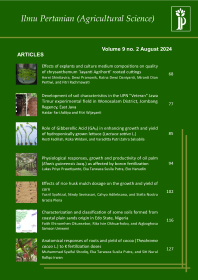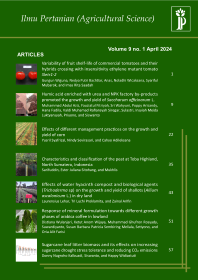Growth and Yield of Rice (Oryza sativa L.) Under Raised- and Sunken-Bed System as Affected by Saline Irrigation in Baros, Bantul, Yogyakarta
Nafi'atul Muflikhah(1*), Budiastuti Kurniasih(2), Tohari Tohari(3)
(1) Faculty of Agriculture Universitas Gadjah Mada, Yogyakarta
(2) Faculty of Agriculture Universitas Gadjah Mada, Yogyakarta
(3) Faculty of Agriculture Universitas Gadjah Mada, Yogyakarta
(*) Corresponding Author
Abstract
It is expected that by utilizing marginal land (e.g. saline field) is able to increase rice production under saline condition. One of integrated approaches that can be applied is a raised- and sunken-bed system. This experiment aimed to investigate the growth and yield of rice under raised- and sunken-bed system as affected by saline irrigation. The field experiment was conducted at Baros Helmet, Bantul District, Yogyakarta from October 2016 to February 2017. The experiment was arranged in a multi-location (oversite) design, consisted of saline irrigation (S1) and nonsaline irrigation (S0) in a raised-bed (A1) and sunken-bed (A0) planting system. The observations were done on leaf area index, chlorophyll a, chlorophyll b, total chlorophyll, photosynthesis rate, total dry weight, root length, leaf Na+ and K+ concentration, proline concentration, maturity and dry grain yield (DGY). The results showed that saline irrigation negatively affected leaf area index, photosynthetic rate and root length of rice grown at sunken-bed. However, leaf Na+ concentration and leaf proline concentrations of rice grown at sunken-bed were higher. The leaf K+ concentration decreased with increasing Na+ concentration. Although saline irrigation could accelerate harvesting age of rice grown at sunken-bed, the dry grain yield of rice grown at sunken-bed did not significantly different with that of rice grown at raised-bed.
Keywords
Full Text:
PDFReferences
Ashraf, M & Foolad, M.R. 2007. Improving Plant Abiotic-stress Resistance by Exogenous Application of Osmoprotectants Glycine Betain and Proline. Journal Environment Experiment Botany 59.
Atamaja, Ruslia. 2013. Planting with Surjan System in Tidal Land. Agricultural Research Institute of Swamp Land (Balittra)-Agricultural Research Agency. http://cybex.pertanian.go.id. (Accessed May, 9 2017)
Cha-um, S., Ashraf, M. & Kirdmanee, C. 2010. Screening Upland Rice (Oryza sativa L. ssp. Indica) Genotypes for Salt-Tolerance Using Multivariate Cluster Analysis. African Journal of Biotechnology. 9(30).
Chinnusamy, V., Jagendorf, A & Zhu, J.K. 2005. Understanding and improving salt tolerance in plants. Crop Sci, 45: 437–48.
Da Silva, E.C., Nogueira, R.J.M.C., De Araujo, F.P., De Melo, N.F. & De Azevedo Neto, A.D. 2008. Physiological Respon to Salt Stress in Young Umbu Plants. Journal Environmental and Experimental Botany.
FAO. 2005. FAO Field Guide 20 things to know about the impact of sea water on agricultural land in NAD Province. http://www.fao.org. (Accessed, December 15, 2016).
Flowers, T.J. and Colmer, T.D., 2015. Plant salt tolerance: adaptations in halophytes. Annals of botany, 115(3), pp.327-331.
Gardner, F.P., Pearce, R.B & Mitchell, R.L. 1991. Physiology of Crop Plants. University of Indonesia Press.
Hamim. 2004. Underlaying Drought Stress Effects on Plants : Inhibition of Photosynthesis. Jurnal Hayati 11.
Hapsoh. 2006. Physiological Response Several Soybean Genotypes Symbiotic with MVA to Various Levels of Drought Relief. Journal of Biology 13(2).
Hasanah, N.A.U. 2016. Growth and Yield of the three rice (Oryza sativa L.) cultivars at different levels of salinity on coastal sandy land. Thesis. Gadjah Mada University.
Levitt, J. 1980. Responses of Plant to Environmental Stresses 2nd ed.New York.Academic pr. 607 p.
Munns, R. and Tester, M., 2008. Mechanisms of salinity tolerance. Annu. Rev. Plant Biol., 59, pp.651-681.
Nazemi, D., Hairani, A. & Indrayati, L., 2012. Prospects for Surjan Land System Development in Tidal Swamp Land. Agrovigor, 5(2), pp.113-118.
Rezaei, M., Davatgar, N., Ashrafzade, A., Pirmoradian, N., Khaledian, M.R., Amiri, E. & Vazifedost, M. 2011. Intermittent Irrigation: AProcedure to Use Saline Water in Rice Cultivation. International Congress on Irrigation and Drainage, Teheran.
Shaaban, M., M. Abid, & R.A.I. Abou-Shanab. 2013. Amelioration of Salt Affected Soils in Rice Paddy System by Application of Organic and Inorganic Amendments. Plant Soil Environment 5.
Shannon, M.C., Rhoades, J.D., Draper, J.H., Scardaci, S.C. & Spyres, M.D. 1998. Assessment of salt tolerance in rice cultivars in response to salinity problems in California Sci., 38, 394-398.
Sunghening, W. 2015. Characteristics Physiology and Yield Mung Bean (Vigna radiate, L.) at Different Shade Level at Bugel Coastal land, Kulon Progo. (Thesis). Gadjah Mada University
Tohari. 2017. Gravimetric Approach Method: A simple, rapid, and promising method for estimating root length and root surface area of rice crop using their root characteristic of dry weight, length, and root diameter. Personal Communication.December 28, 2017. Universitas Gadjah Mada.
Yoshida, S. 1981. Fundamentals of Rice Crop Science.The International Rice Research Institute.Los Banos, Philippines.
Zeng, L., Shannon, M.C. & Lesch, S.M. 2001. Timing of salinity stress affects rice growth and yield components. Agric. Water Manage. 48, 191–206.
Article Metrics
Refbacks
- There are currently no refbacks.
Ilmu Pertanian (Agricultural Science) ISSN 0126-4214 (print), ISSN 2527-7162 (online) is published by Faculty of Agriculture Universitas Gadjah Mada collaboration with Perhimpunan Sarjana Pertanian Indonesia (PISPI) and licensed under a Creative Commons Attribution-ShareAlike 4.0 International License.













